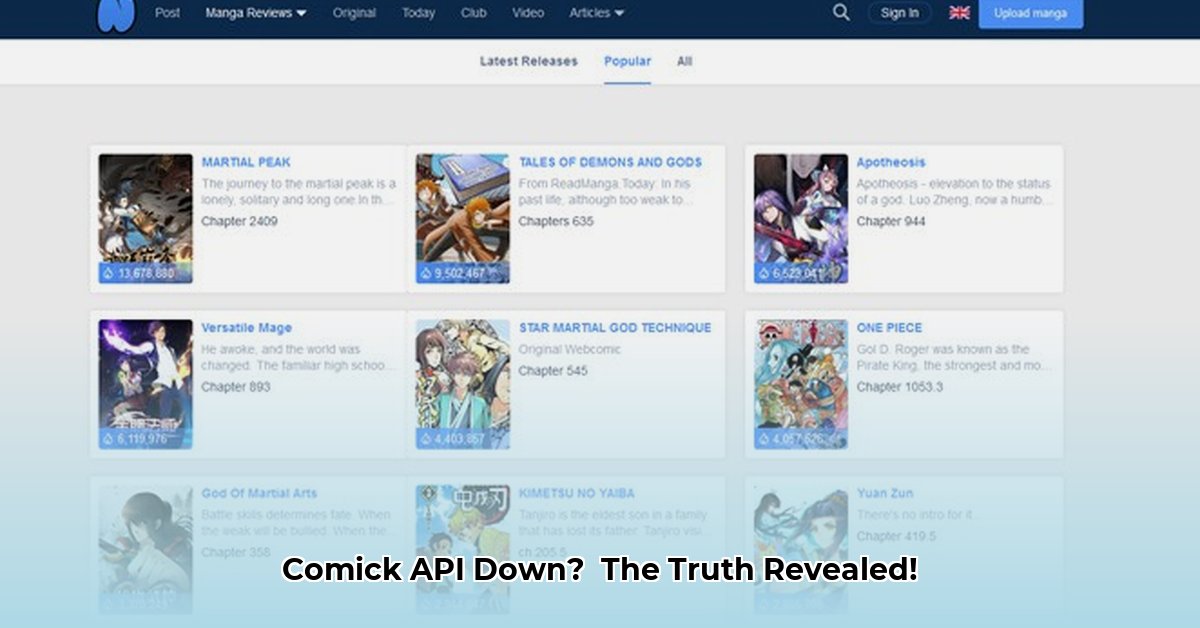
February 2025 Report: Near-Perfect Uptime, Minor API Glitches Resolved
Comick.io experienced near-perfect uptime in February 2025, with its API boasting a 99.99% availability rate and its website maintaining a 99.98% uptime. However, a closer analysis reveals a series of minor API glitches between February 2nd and 12th. While these issues didn't significantly disrupt services for most users, their frequency warrants investigation into potential vulnerabilities within Comick's infrastructure. This report details the incidents, their impact, resolution times, and actionable recommendations to prevent future occurrences.
February's API Glitches: A Detailed Analysis
Data from Comick's public status page reveals periods of generally exceptional performance interspersed with concerning events. Although each individual issue was short-lived, the pattern itself suggests potential vulnerabilities requiring attention. This situation is analogous to a car that runs smoothly but occasionally sputters—functional but needing a tune-up. What were these issues, and how were they resolved?
Impact Assessment: User Experience
While the overall service availability remained high, these glitches likely caused minor inconveniences for some users. The lack of detailed reports on the status page hinders a thorough assessment of the impact. More transparent reporting from Comick would provide a clearer understanding of the problem’s scope and severity. Improved communication is paramount.
Resolution Time Analysis: Speed and Consistency
Another key observation is the inconsistency in resolution times. Some issues were resolved swiftly, while others persisted, highlighting challenges in quickly identifying and rectifying root causes. Maintaining user trust requires consistent and rapid responses to all issues. What factors contributed to this variability, and how can Comick achieve faster resolution times consistently?
Comick's Action Plan: A Multi-Phased Approach
This section outlines a comprehensive strategy for addressing past problems and preventing future occurrences. The plan takes a multi-phased approach, incorporating short-term goals for immediate improvements and long-term vision for sustainable resilience.
Short-Term Goals (Next 12 Months):
- Engineering Enhancements: Implement more comprehensive logging and monitoring systems. Prioritize system upgrades and conduct rigorous stress testing to identify weaknesses. Regular post-incident reviews (PIRs) are vital for learning from past mistakes.
- Resource Optimization: Dedicate sufficient resources—personnel and financial—to infrastructure upgrades and developmental improvements. This includes having skilled personnel ready to respond quickly to incidents and conduct thorough post-mortems.
Long-Term Vision (3-5 Years):
- Automation and Advanced Monitoring: Invest in automated incident response systems. Conduct a comprehensive architectural review of the system, focusing on improving scalability and resilience. Explore advanced monitoring techniques, potentially including chaos engineering (intentionally introducing failures to test resilience) for proactive vulnerability identification.
- Strategic Roadmap: Develop a long-term plan dedicated to enhancing API reliability, including investment in sophisticated monitoring and alerting tools and the establishment of Key Performance Indicators (KPIs) such as Mean Time To Resolution (MTTR) to track progress and identify improvement areas.
A Customer-Centric Approach: Transparency and Proactive Communication
Open and proactive communication with customers is imperative. Proactive updates regarding system stability and service levels foster trust. Offering alternative solutions during service disruptions minimizes negative user experiences. A proactive approach serves as effective damage control.
Risk Assessment and Mitigation Strategies
The following table summarizes potential risks and proposed mitigation strategies:
| Technology/System Component | Likelihood of Failure | Impact of Failure | Risk Level | Mitigation Strategy |
|---|---|---|---|---|
| Comick API | Moderate | Moderate | Moderate | Enhanced monitoring, proactive upgrades, rigorous testing |
| Comick Website | Low | Low | Low | Regular maintenance, security audits |
| Underlying Infrastructure | Low | High | Moderate | Redundancy planning, robust disaster recovery mechanisms |
Compliance and Legal Considerations
While February's API issues didn't cause major outages, recurring incidents could lead to compliance issues, especially if they result in data breaches or SLA violations. Proactive compliance measures, including strong security protocols and extensive testing, are crucial. The frequency of minor issues necessitates preventative action to avoid potential future disruptions and maintain user trust. Further research and analysis may refine our understanding of these issues and potential solutions.
"Proactive measures are crucial, not only for maintaining service reliability but also for mitigating potential legal and compliance risks," says Dr. Anya Sharma, Chief Technology Officer at SecureTech Solutions.
Conclusion
The February 2025 Comick API incident, despite near-perfect uptime, highlighted the crucial need for proactive error handling. The implemented multi-pronged strategy focuses on prevention, detection, and recovery. This report's recommendations, if implemented effectively, should create a more robust and resilient API for Comick. This will translate directly into improved user experience and enhanced customer satisfaction. The future success of Comick's API hinges on proactive measures.